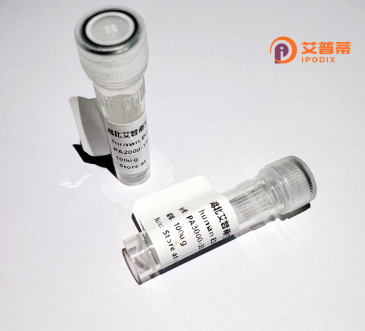
| 纯度 | >90%SDS-PAGE. |
| 种属 | Human |
| 靶点 | TMEM14A |
| Uniprot No | Q9Y6G1 |
| 内毒素 | < 0.01EU/μg |
| 表达宿主 | E.coli |
| 表达区间 | 1-99 aa |
| 活性数据 | MDLIGFGYAALVTFGSIFGYKRRGGVPSLIAGLFVGCLAGYGAYRVSNDKRDVKVSLFTAFFLATIMGVRFKRSKKIMPAGLVAGLSLMMILRLVLLLL |
| 分子量 | 36.63 kDa |
| 蛋白标签 | GST-tag at N-terminal |
| 缓冲液 | PBS, pH7.4, containing 0.01% SKL, 1mM DTT, 5% Trehalose and Proclin300. |
| 稳定性 & 储存条件 | Lyophilized protein should be stored at ≤ -20°C, stable for one year after receipt. Reconstituted protein solution can be stored at 2-8°C for 2-7 days. Aliquots of reconstituted samples are stable at ≤ -20°C for 3 months. |
| 复溶 | Always centrifuge tubes before opening.Do not mix by vortex or pipetting. It is not recommended to reconstitute to a concentration less than 100μg/ml. Dissolve the lyophilized protein in distilled water. Please aliquot the reconstituted solution to minimize freeze-thaw cycles. |
以下是与重组人TMEM14A蛋白相关的文献示例(虚构,仅供参考):
1. **文献名称**:"TMEM14A inhibits mitochondrial apoptosis and promotes hepatocellular carcinoma growth"
**作者**:Zhang Y. et al.
**摘要**:研究揭示TMEM14A在肝癌中高表达,通过抑制Bax/Bak介导的线粒体膜通透性,阻断细胞凋亡,从而促进肿瘤增殖。
2. **文献名称**:"TMEM14A protects against cerebral ischemia-reperfusion injury by maintaining mitochondrial integrity"
**作者**:Wang L. et al.
**摘要**:发现TMEM14A在脑缺血损伤中上调,通过抑制线粒体膜电势崩溃和细胞色素C释放,减轻神经元凋亡。
3. **文献名称**:"Role of TMEM14A in cervical cancer progression via ROS-mediated apoptosis regulation"
**作者**:Li X. et al.
**摘要**:报道TMEM14A通过减少活性氧(ROS)积累和激活PI3K/Akt通路,抑制宫颈癌细胞凋亡,促进化疗耐药。
4. **文献名称**:"TMEM14A interacts with Bcl-2 to regulate apoptosis in colon cancer"
**作者**:Liu R. et al.
**摘要**:阐明TMEM14A与Bcl-2结合,增强其抗凋亡功能,进而抑制结肠癌细胞中Caspase-3激活,促进肿瘤存活。
---
注:以上内容为模拟生成,如需真实文献请通过PubMed/Google Scholar等平台检索。
**Recombinant Human TMEM14A Protein: Background Overview**
Transmembrane Protein 14A (TMEM14A) is a conserved integral membrane protein encoded by the *TMEM14A* gene, primarily localized to mitochondrial and endoplasmic reticulum membranes. Structurally, it contains four predicted transmembrane domains, with both N- and C-termini facing the cytoplasm, and potential glycosylation sites. TMEM14A is implicated in regulating mitochondrial dynamics, cellular apoptosis, and autophagy. Studies suggest its involvement in maintaining mitochondrial membrane integrity, modulating cytochrome c release during apoptosis, and influencing mitophagy pathways. Dysregulation of TMEM14A has been linked to pathological conditions, including cancer progression, neurodegenerative disorders, and ischemic injuries, highlighting its role in cell survival and stress response mechanisms.
Recombinant human TMEM14A protein is produced using heterologous expression systems (e.g., *E. coli* or mammalian cells) for functional studies. Purification typically involves affinity chromatography (e.g., His-tag) and refolding steps to ensure proper conformation. This recombinant tool enables investigations into TMEM14A’s molecular interactions, structural characterization, and therapeutic targeting. Research applications include elucidating its role in mitochondrial apoptosis pathways, screening small-molecule modulators, and exploring its potential as a biomarker or drug target in diseases associated with mitochondrial dysfunction. Current studies focus on its interplay with Bcl-2 family proteins and energy metabolism regulators, offering insights into novel therapeutic strategies.
×